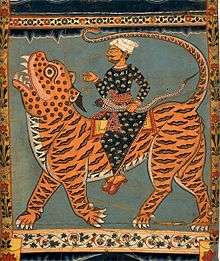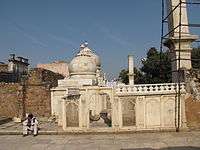Shah Alam II
Ali Gohar (25 June 1728 – 19 November 1806), historically known as Shah Alam II, was the sixteenth Mughal Emperor and the son of Alamgir II. Shah Alam II became the emperor of a crumbling Mughal empire. His power was so depleted during his reign that it led to a saying in the Persian language, Sultanat-e-Shah Alam, Az Dilli ta Palam, meaning, 'The empire of Shah Alam is from Delhi to Palam', Palam being a suburb of Delhi.[1][2]
| Shah Alam II | |||||
|---|---|---|---|---|---|
| Mughal Emperor | |||||
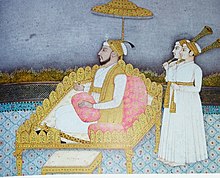 Mughal Emperor Shah Alam II, seated on a throne | |||||
| 16th Mughal Emperor | |||||
| 1st reign | 10 October 1760 – 31 July 1788 | ||||
| Predecessor | Shah Jahan III | ||||
| Successor | Muhammad Shah Bahadur | ||||
| 2nd reign | 16 October 1788 – 19 November 1806 | ||||
| Predecessor | Muhammad Shah Bahadur | ||||
| Successor | Akbar Shah II | ||||
| Born | 25 June 1728 Shahjahanabad, Subah of Delhi, Mughal Empire (present-day Old Delhi, Delhi, India) | ||||
| Died | 19 November 1806 (aged 78) Shahjahanabad, Subah of Delhi, Mughal Empire | ||||
| Burial | Zafar Mahal, Mehrauli, Delhi | ||||
| Spouse | Piari Begum Taj Mahal Begum Jamil un-nisa Begum Mubaraq Mahal Murad Bakht Begum | ||||
| Issue | Over 16 sons (including Akbar II and Mirza Jawan Bakht) and 2 daughters | ||||
| |||||
| House | Timurid | ||||
| Father | Alamgir II | ||||
| Mother | Zinat Mahal | ||||
| Religion | Islam | ||||
Shah Alam faced many invasions, mainly by the Emir of Afghanistan, Ahmed Shah Abdali, which led to the Third Battle of Panipat between the Maratha Empire, who maintained suzerainty over Mughal affairs in Delhi and the Afghans led by Abdali. In 1760, the invading forces of Abdali were driven away by the Marathas, led by Sadashivrao Bhau, who deposed Shah Jahan III, the puppet Mughal emperor of Feroze Jung III, and installed Shah Alam II as the rightful emperor under Maratha control.[3][4]
Shah Alam II was considered the only and rightful emperor, but he wasn't able to return to Delhi until 1772, under the protection of the Maratha general Mahadaji Shinde. He also fought against the British East India Company at the Battle of Buxar.
Shah Alam II authored his own Diwan of poems and was known by the pen-name Aftab. His poems were guided, compiled and collected by Mirza Fakhir Makin.[5]
Shah Alam also penned famous book Ajaib-ul-Qasas which is considered one of the earliest and prominent book of prose in Urdu.
Early life
Ali Gohar was born to "Shahzada" (Prince) Aziz-ud-Din, son of the deposed Mughal Emperor Jahandar Shah, on 25 June 1728. Alongside his father, he grew up in semi-captivity in the Salatin quarters of the Red Fort. However, unlike the majority of Mughal princes growing up in similar circumstances, he is not recorded to have become a decadent prince by the time his father became emperor, and therefore was naturally given high appointments in the course of his father's reign.
Upon his father's accession, he became the "Wali Ahd" (Crown Prince) of the empire, and became his father's principal agent, though almost all power lay in the Wazir Imad-ul-Mulk's hand. His quarrels with that amir, and fear for his own life, caused him to flee from Delhi in 1758.
Escape from Delhi
Prince Ali Gauhar, afterwards Emperor Shah Alam II, had been the heir apparent of his father Alamgir II. Prince Ali Gauhar's father had been appointed Mughal Emperor by Vizier Feroze Jung III and Maratha Peshwa's brother Sadashivrao Bhau[6].
Prince Ali Gauhar organized a militia and made a daring escape from Delhi, Prince Ali Gauhar appeared in the Eastern Subah in 1759, hoping to strengthen his position by attempting to regaining control over Bengal, Bihar and Odisha.
Very soon however, Najib-ud-Daula, forced the usurper Feroze Jung III to flee from the capitol after he gathered a large Mughal Army outside Delhi, which deposed the recreant Shah Jahan III. Najib-ud-Daula and Muslim nobles then planned to defeat the Marathas by maintaining correspondence with the powerful Ahmad Shah Durrani. After Durrani decisively defeated the Marathas, he nominated Ali Gauhar as the emperor under the name Shah Alam II.[7]
Bengal War
In 1760, after Shah Alam's militia gaining control over pockets in Bengal, Bihar and parts of Odisha, Prince Ali Gauhar and his Mughal Army of 30,000 intended to overthrow Mir Jafar and Feroze Jung III after they tried to capture or kill him by advancing towards Awadh and Patna in 1759. But the conflict soon involved the intervention of the assertive East India Company.
The Mughals clearly intended to recapture their breakaway Eastern Subah led by Prince Ali Gauhar, who was accompanied by a Militia consisting of persons like Muhammad Quli Khan, Kadim Husein, Kamgar Khan, Hidayat Ali, Mir Afzal and Ghulam Husain Tabatabai. Their forces were reinforced by the forces of Shuja-ud-Daula, Najib-ud-Daula and Ahmad Shah Bangash. The Mughals were also joined by Jean Law and 200 Frenchmen and waged a campaign against the British during the Seven Years' War.[8]
Prince Ali Gauhar successfully advanced as far as Patna, which he later besieged with a combined army of over 40,000 in order to capture or kill Ramnarian a sworn enemy of the Mughals. Mir Jafar was in terror at the near demise of his cohort and sent his own son Miran to relieve Ramnarian and retake Patna. Mir Jafar also implored the aid of Robert Clive, but it was Major John Caillaud, who dispersed Prince Ali Gauhar's army in 1761 after four major battles including Battle of Patna, Battle of Sirpur, Battle of Birpur and Battle of Siwan.
After negotiations assuring peace Shah Alam II was escorted by the British to meet Mir Qasim the new Nawab of Bengal, who was nominated after the sudden death of Miran. Mir Qasim soon had the Mughal Emperor's investiture as Subedar of Bengal, Bihar and Odisha, and agreed to pay an annual revenue of 2.4 million dam. Shah Alam II then retreated to Allahabad was protected by the Shuja-ud-Daula, Nawab of Awadh from 1761 until 1764. Meanwhile, Mir Qasim's relations with the British East India company began to worsen. He initiated reforms that withdrew the tax exemption enjoyed by the British East India Company, he also ousted Ramnarian a sworn enemy of the Mughal Empire and created Firelock manufacturing factories at Patna with the sole purpose of giving advantage to the newly reformed Mughal Army.
Angered by these developments the East India Company sought his ouster. Court intrigues encouraged by the East India company forced Mir Qasim to leave Bengal, Bihar and Odisha. Mir Qasim on his part encouraged Shuja-ud-Daula the Nawab of Awadh and Shah Alam II to engage the British.
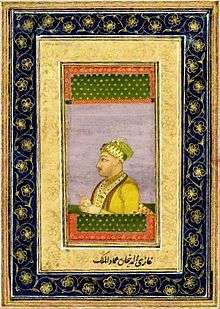 Feroze Jung III was the regent imposed by the Maratha Confederacy in 1757, who assassinated Alamgir II and prominent members of the imperial family, within the Maratha controlled city of Delhi; Shah Alam II managed to escape to safety with the Nawab of Awadh.[9]
Feroze Jung III was the regent imposed by the Maratha Confederacy in 1757, who assassinated Alamgir II and prominent members of the imperial family, within the Maratha controlled city of Delhi; Shah Alam II managed to escape to safety with the Nawab of Awadh.[9]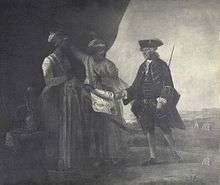 Mir Jafar, his son Miran and Ramnarian refused to submit to Shah Alam II, who initiated the Bengal War causing the eventual intervention of the British East India Company.
Mir Jafar, his son Miran and Ramnarian refused to submit to Shah Alam II, who initiated the Bengal War causing the eventual intervention of the British East India Company.
Acknowledged emperor
Shah Alam II was acknowledged emperor by the Durrani Empire. His declared reign extended to the 24 Parganas of the Sundarbans,[10] Mir Qasim, Nawabs of Bengal and Murshidabad (and Bihar),[10]Raja of Banares,[11] Nizam of Hyderabad, Nawab of Ghazipur, Sahib of Punjab, Hyder Ali's Mysore,[11] Nawab of Kadapa and Nawab of Kurnool, Nawab of the Carnatic of Arcot and Nellore,[12] Nawab of Junagarh, Rohilkhand of Lower Doab, Rohilkhand of Upper Doab, and Nawab of Bhawalpur.
Battle of Buxar
The Battle of Buxar was fought on 22 October 1764 between the combined armies of Mir Qasim, the Nawab of Bengal; Shuja-ud-Daula the Nawab of Awadh; the Mughal Emperor Shah Alam II and the forces under the command of the British East India Company led by Hector Munro.[13] The battle fought at Buxar, a town located on the bank of the Ganges river then within the territory of Bengal, was a decisive victory for the British East India Company.
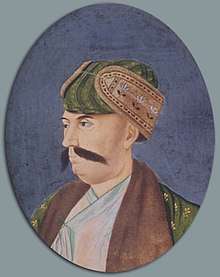 Shuja-ud-Daula served as the leading Nawab Vizier of the Mughal Empire, during the Third Battle of Panipat and the Battle of Buxar
Shuja-ud-Daula served as the leading Nawab Vizier of the Mughal Empire, during the Third Battle of Panipat and the Battle of Buxar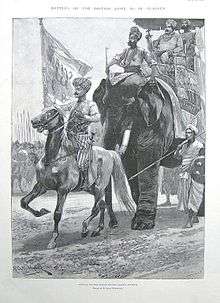 Nawab of Bengal, Mir Qasim defected to Shah Alam II.
Nawab of Bengal, Mir Qasim defected to Shah Alam II.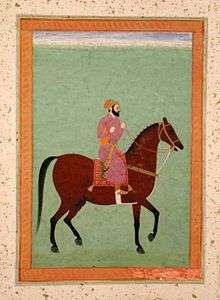 Mirza Najaf Khan, the commander-in-chief of the Mughal Army.
Mirza Najaf Khan, the commander-in-chief of the Mughal Army.
Diwani rights
Soon after the Battle of Buxar, Shah Alam II, a sovereign who had just been defeated by the British, sought their protection by signing the Treaty of Allahabad in the year 1765. Shah Alam II was forced to grant the Diwani (right to collect revenue) of Bengal (which included Bihar and Odisha) to the British East India Company in return for an annual tribute of 2.6 million rupees to be paid by the company from the collected revenue. Tax exempt status was also restored to the company. The company further secured for the districts of Kora and Allahabad which allowed the British East India Company to collect tax from more than 20 million people. East India company thus became the Imperial tax collector in the former Mughal province of Bengal (which included Bihar and Odisha). East India company appointed a deputy Nawab Muhammad Reza Khan to collect revenue on behalf of the company.
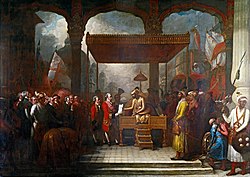 Shah Alam II granting Robert Clive the "Diwani rights of Bengal, Behar and Odisha" in return for the annexed territories of the Nawab of Awadh after the Battle of Buxar, on 12 August 1765 at the Benares.
Shah Alam II granting Robert Clive the "Diwani rights of Bengal, Behar and Odisha" in return for the annexed territories of the Nawab of Awadh after the Battle of Buxar, on 12 August 1765 at the Benares. A member of the British East India Company enjoying a Durbar.
A member of the British East India Company enjoying a Durbar.
Absence from Delhi
Shah Alam II's absence from Delhi was due to the terms of the treaty he had signed with the British. But his son and heir apparent Prince Mirza Jawan Bakht and Najib-ul-Daula, represented the emperor for the next 12 years in Delhi.
Bengal Famine
The Bengal Famine in 1770 was a massive catastrophe that signalled the end of the Mughal Empire and disorder in the Indian Subcontinent.
By the time the famine occurred it became very clear that the Mughal Empire was no longer a major political power, not only in the general world but also within South Asia.
Return to Delhi
Shah Alam II returned to the throne in Delhi in 1772, under the protection of the Maratha general Mahadaji Shinde.[14] The emperor became a client of the Maratha whose Peshwa demanded tribute, which the Moguls are known to have paid so as to avoid any further conflict with the Confederacy.
The emperor resided in the fort of Allahabad for six years. Warren Hastings, the head of East India company got appointed as the first Governor of Bengal in 1774. This was the period of "Dual rule" where East India company enacted laws to maximise collection of revenue and the Mughal Emperor appointed Nawab looked after other affairs of the province. East India company later discontinued the tribute of 2.6 million Rupees and later also handed over the districts of Allahabad and Kara to the Nawab of Awadh. These measures amounted to a repudiation of the company's vassalage to the emperor as Diwan (tax collector). In 1793 East India Company was strong enough and abolished Nizamat (local rule) completely and annexed Bengal. Weakened Shah Alam II agreed to the consultation of the East India Company, who advised him never to trust the Marathas.
In the year 1771 the Marathas under Mahadji Shinde returned to northern India and even captured Delhi. Shah Alam II, was escorted by Mahadaji Shinde and left Allahabad in May 1771 and in January 1772 reached Delhi. Along with the Marathas they undertook to win the crown lands of Rohilkhand and defeated Zabita Khan, capturing the fort of Pathar garh with its treasure.
In the year 1787, an embassy of Bijaya Singh from Jodhpur presented itself to the Mughal Emperor Shah Alam II, bringing homage and the golden key of the Fortress of Ajmer.[15]
After killing Ghulam Qadir and restoring Shah Alam II to the throne, a Maratha garrison permanently occupied Delhi in 1788 and ruled on north India for next two decades until they were usurped by the British East India Company in the Second Anglo-Maratha War.[16]
 The Royal Chamber in the Public Audience Hall in the Middle of Yazdah Darreh, with the Ruler, Alam Bahador Badshah, and the Great Commanders, a page from the Lady Coote Album.
The Royal Chamber in the Public Audience Hall in the Middle of Yazdah Darreh, with the Ruler, Alam Bahador Badshah, and the Great Commanders, a page from the Lady Coote Album.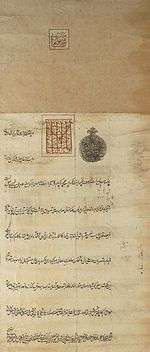 A Firman issued by the Mughal Emperor Shah Alam II, dated 1776.
A Firman issued by the Mughal Emperor Shah Alam II, dated 1776.
Reformation of the Mughal Army
One of his first acts was to strengthen and raise a new Mughal Army, under the command of Mirza Najaf Khan. This new army consisted of infantrymen who successfully utilised both Flintlocks and Talwars in combat formations,[17] they utilised elephants for transportation and were less dependent on artillery and cavalry. Mirza Najaf Khan is also known to have introduced the more-effective Firelock muskets through his collaboration with Mir Qasim, the Nawab of Bengal.[18]
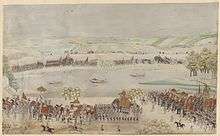 The newly reestablished Mughal Army during the reign of Shah Alam II.
The newly reestablished Mughal Army during the reign of Shah Alam II.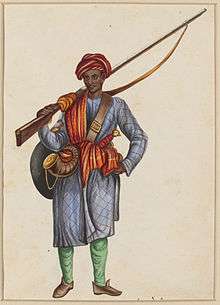 A Mughal infantryman.
A Mughal infantryman. Large Mughal Army encampments during the reign of the Mughal Emperor Shah Alam II.
Large Mughal Army encampments during the reign of the Mughal Emperor Shah Alam II.
Foreign relations
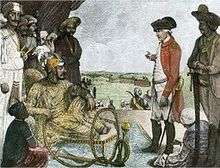
Shah Alam II, was well supported by Jean Law de Lauriston and 200 Frenchmen during his campaign to regain the Eastern Subahs (during the Seven Years' War). The brainchild of the campaign was Ghulam Husain Tabatabai, who had gained much administrative and military experience from both the French and the Dutch.
After Shah Alam II's defeat in the Battle of Buxar, the French once again reached out to emperor under Pierre André de Suffren in the year 1781, who initiated a plan to capture Bombay and Surat from the Maratha Confederacy and the British, with the co-operation of Mirza Najaf Khan, this action would eventually lead to Asaf Jah II to join Shah Alam II and the French and assist Hyder Ali to capture Madras from the British East India Company.[19] The internal conflicts within the Mughal imperial court would not allow the emperor to make such a bold move against the British.
 Pierre André de Suffren ally of Hyder Ali and also Shah Alam II.
Pierre André de Suffren ally of Hyder Ali and also Shah Alam II.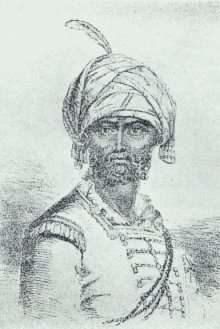 Hyder Ali was bestowed the title Shams ul-Mulk and Amir ud-Daula by Shah Alam II, his pro-French policies were a continuation of the Mughal Empire's policies during the Seven Years' War.
Hyder Ali was bestowed the title Shams ul-Mulk and Amir ud-Daula by Shah Alam II, his pro-French policies were a continuation of the Mughal Empire's policies during the Seven Years' War.
Rumi Darwaza
The Rumi Darwaza, which stands sixty feet tall,[20] was modelled (1784) after the Sublime Porte (Bab-i Hümayun) in Istanbul, is one of the very important examples of the exchange between the two cultures.[21]
- Entrance gate built by the Nawab of Oudh, replicating the Sublime Porte (Bab-iHümayun) in Istanbul.
Political turmoil
Jat victories
Jats rose in retaliation of religious intolerance pursued by Aurangzeb.[22] The Jat kingdom of Bharatpur waged many wars against the Mughal Delhi and in the 17th and 18th century carried out numerous campaigns in Mughal territories including Agra.[23] Mughals were defeated by Marathas in 1757; and Mughal possessions and territories were under the annexation of the Jat's led by Suraj Mal.
During one massive assault, Jats sieged Agra in 1761, after 20 days on 12 June 1761 the Mughal forces at Agra surrendered to Jats.[22] Jats plundered the city as was the norm of victors during those days. They carried the bounty, including the two great silver doors to the entrance of the famous Taj Mahal. which were carried off and melted down by Suraj Mal in 1764.[24]
Suraj Mal's son Jawahar Singh, further extended the Jat power in Northern India and captured the territory in Doab, Ballabgarh and Agra.[25] Jats kept Agra fort and other territories closer to Delhi under their control from 1761 till 1774 CE.[22]
Sikh victories
Sikhs had been in perpetual war against Mughal intolerance specially after beheading of the Sikh Guru - Guru Teg Bahadur by the Mughals. Simmering Sikhs rose once again in the year 1764 and overran the Mughal Faujdar of Sirhind, Zain Khan Sirhindi, who fell in battle and ever since the Sikhs perpetually raided and took the bounties from the lands as far as Delhi practically every year. They attacked, won and extracted payments from Delhi three times in 11 years particularly in 1772, 1778 and 1783. And it is believed that the Sikhs even had informants, probably even the Viziers of Shah Alam II. There was ongoing warfare with the Sikhs who were regaining their traditional homeland in eastern Punjab and also attacking the Rohilla, Mewar and Jat lands. During Shah Alam II's reign the Sikhs fought not just with the Mughals, but with the Marathas, Rajputs, and Rohillas.
The Marathas took Delhi in 1772 before Shah Alam II arrived. Mirza Najaf Khan had restored a sense of order to the Mughal finances and administration and particularly reformed the Mughal Army. In 1777 Mirza Najaf Khan decisively defeated Zabita Khan's forces and repelled the Sikhs after halting their raids.
In 1778, after a Sikh incursion into Delhi, Shah Alam ordered their defeat by appointing, the Mughal Grand Vizier, Majad-ud-Daula marched with 20,000 Mughal troops against the Sikh army into hostile territories, this action led to the defeat of the Mughal Army at Muzzaffargarh and later at Ghanaur, due to the mounted casualties Shah Alam II reappointed Mirza Najaf Khan, who soon died of natural circumstances leaving the Mughal Empire weaker than ever.
In the year 1779, Mirza Najaf Khan carefully advanced his forces who successfully routed the treasonous Zabita Khan and his Sikh allies who lost more than 5,000 men in a single battle and never returned to threaten the Mughal Empire during the commander Mirza Najaf Khan's lifetime. Najaf Khan as prime minister, granted sovereign rights to the Sikhs as agreement.[26]
In the year 1783, Farzana Zeb un-Nissa had saved Delhi from a possible invasion by a force of 30,000 Sikh troops, under Baghel Singh, Jassa Singh Ramgarhia and Jassa Singh Ahluwalia.
Mughal empire disintegrated to such an extent that Shah Alam II was only left with Delhi city to rule. 1781, Jassa Singh Ahluwalia and Baghel Singh laid siege to the city. After entering Red fort, Jassa Singh Ahluwalia sat on the Mughal throne on behest of Baghel Singh and a title of Badshah Singh was given to him. Begum Samru requested Baghel Singh to show mercy on Shah Alam II. Baghel Singh accepted and stated his demands such as 30000 of his troops to stay in Delhi and the Mughal Empire would pay for their maintenance. Other demands were the construction of at least 5 Gurdwaras and annual tax payment of 13.5%. The demands were agreed upon by Shah Alam II with a written agreement. Since Sikhs refused to accept authority of the Mughal court due to politics, Mahadji Shinde was given the regency with an agreement that he will pay the Sikhs 1/3 of the revenue annually.[27]
Zabita Khan was the Rohilla chief who reached a settlement with the Sikhs and merely became their puppet. He requested to be baptised to Sikhism to prove his loyalty to Sikhs. After his baptism which was performed by Baghel Singh, Zabita Khan was given Sikh name Dharam Singh. Rohilla chief entered Delhi unleashing terror and causing Shah Alam II to go blind in August 1786. This treacherous act was unaccepted by the Sikhs and Zabita Khan was disowned leaving him with no allies. Zabita Khan was captured and executed by the Marathas for the atrocities committed by him in the city.[27]
1799, Ranjit Singh brought all the Sikh Misls together to form an empire, the Sikh Empire.
Downfall

After the defeats at Muzaffargarh and later at Ghanaur, Majad-ud-Daula was arrested by the orders of Shah Alam II, who then recalled Mirza Najaf Khan. This led to the former Grand Vizier's arrest for causing miscalculations and collaborating with the enemies of the emperor. The traitor was imprisoned and a sum of two million dam in stolen revenue recovered from him. It was Shah Alam II's poor judgement and vacillation that led to his own downfall. Mirza Najaf Khan had given the Mughal Empire breathing space by having a powerful, well managed army in its own right. In 1779 the newly reformed Mughal Army decisively defeated Zabita Khan and his Sikh allies the rebels lost 5,000 men including their leader and therefore did not return during the lifetime of Mirza Najaf Khan. Unfortunately upon the general's death, Shah Alam's bad judgement prevailed. The dead man's nephew, Mirza Shafi whose valour had been proven during various occasions, was not appointed commander in chief. Shah Alam II instead appointed worthless individuals whose loyalty and record were questionable at best. They were soon quarrelling over petty matters. Even the corrupt and treasonous former Grand Vizier, Majad-ud-Daula was restored to his former office, he later colluded with the Sikhs and reduced the size of the Mughal Army from over 20,000 to only 5,000 thus bringing the Mughal Emperor Shah Alam II at the mercy of his ruffian enemies.[28]
Benoît de Boigne, (1790).
%2C_the_blind_mughal_Emperor%2C_seated_on_a_golden_throne..jpg)
Prisoner of Ghulam Qadir
Nawab Majad-ud-Daula was followed by a known enemy of the Mughals, the grandson of Najib Khan, Ghulam Qadir, with his Sikh allies forced Shah Alam II to appoint him as the Grand Vizier of the Mughal Empire. Petty, avaricious and insane Ghulam Qadir ravaged the palaces in search of the Mughal treasure believed to be worth Rs.250 million. Unable to locate even a fraction of that sum and angered by the Mughal Emperor's attempts to eliminate him and his Sikh allies, Ghulam Qadir himself blinded Shah Alam II with an Afghani knife on 10 August 1788.[28] A drunken ruffian, Ghulam Qadir behaved with gross brutality to the emperor and his family. Three servants and two water-carriers who tried to help the bleeding emperor were beheaded and according to one account, Ghulam Qadir would pull the beard of the elderly Mughal Emperor Shah Alam II. After ten horrible weeks, during which Ghulam Qadir stripped the princesses of the royal family naked and forced them to dance naked before him (after which they jumped into Yamuna river to drown) and the honour of the royal family and prestige of the Mughal Empire reached its lowest ebb, Mahadaji Shinde intervened and killed Ghulam Qadir, taking possession of Delhi on 2 October 1788. He restored Shah Alam II to the throne and acted as his protector.[29] Mahadaji Shinde sent the ears and eyes of Ghulam Qadir to Shah Alam.[30]
Client of Mahadji Shinde
Thankful for his intervention, he honoured Mahadji Shinde with the titles of Vakil-ul-Mutlaq (Regent of the Empire) and Amir-ul-Amara (Head of the Amirs). After killing Ghulam Qadir and restoring Shah Alam II to the throne, a Maratha garrison permanently occupied Delhi in 1788 and ruled on north India for next 15 years until they were overthrown by the British East India Company following the Second Anglo-Maratha War in 1803.[16]
Arrival of British troops
The French threat in Europe and its possible repercussions in India caused the British to strive to regain the custody of Shah Alam II. The British feared that the French military officers might overthrow Maratha power and use the authority of the Mughal emperor to further French ambition in India.
Shah Alam II also corresponded with Hyder Ali and later with his son Tipu Sultan during their conflicts with the British East India Company during the Anglo-Mysore Wars and was very well informed about the expansionist agenda of the British.
After the Battle of Delhi (1803), during the Second Anglo-Maratha War, on 14 September 1803 British troops entered Delhi ending the Maratha rule on the Mughals, bringing Shah Alam, then a blind old man, seated under a tattered canopy, under British protection. The Mughal Emperor no longer had the military power to enforce his will, but he commanded respect as a dignified member of the House of Timur in the length and breadth of the country. The Nawabs and Subedars still sought formal sanction of the Mughal Emperor on their accession and valued the titles he bestowed upon them. They struck coins and read the khutba (Friday sermons) in his name. The Marathas in 1804 under Yashwantrao Holkar tried to snatch Delhi from the British in Siege of Delhi (1804), but failed.
Death
Shah Alam II died of natural causes on 19 November 1806.
His grave lies next to the dargah of the 13th century Sufi saint, Qutbuddin Bakhtiar Kaki at Mehrauli, Delhi in a marble enclosure along with that of Bahadur Shah I (also known as Shah Alam I), and Akbar Shah II.
In popular culture
- In the 1994 Hindi TV series The Great Maratha, Shah Alam's character was portrayed by Rishabh Shukla.
Gallery
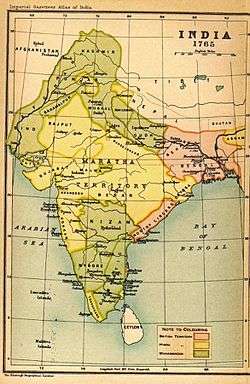 Map of India in 1765, before the fall of Nawabs and Princely states nominally allied to the emperor (mainly in Green).
Map of India in 1765, before the fall of Nawabs and Princely states nominally allied to the emperor (mainly in Green).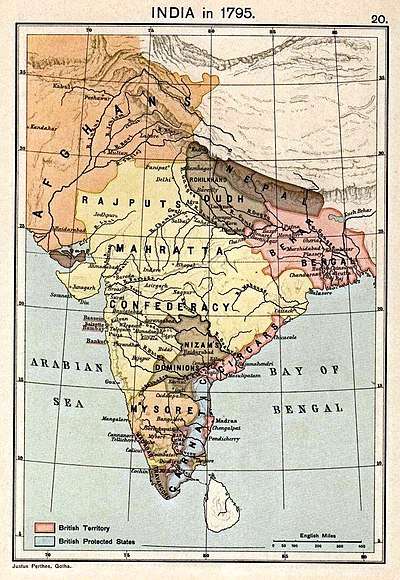 Map of India in 1795, 11 years before the death of Shah Alam II
Map of India in 1795, 11 years before the death of Shah Alam II
See also
| Wikimedia Commons has media related to Shah Alam II. |
| Wikiquote has quotations related to: Shah Alam II |
- Mirza Najaf Khan
- Shuja-ud-Daula
- Hyder Ali
- Muhammed Ali Khan Wallajah
References
- Delhi, Past and Present, p. 4, at Google Books
- History of Islam, p. 512, at Google Books
- Advanced Study in the History of Modern India 1707–1813, p. 140, at Google Books
- S. M. Ikram (1964). "XIX. A Century of Political Decline: 1707–1803". In Ainslie T. Embree (ed.). Muslim Civilization in India. New York: Columbia University Press. Retrieved 5 November 2011.
- Dictionary of Indo-Persian Literature, p. 40, at Google Books
- Mughal Empire in India: A Systematic Study Including Source Material, Volume 3, p. 767, at Google Books
- S.R. Sharma (1 January 1999). Mughal empire in India: a systematic study including source material. Atlantic Publishers & Dist. pp. 769–. ISBN 978-81-7156-819-2. Retrieved 30 March 2012.
- L.S.S. O`malley. Bihar and Orissa District Gazetteers Patna. Concept Publishing Company. pp. 32–. ISBN 978-81-7268-121-0. Retrieved 30 March 2012.
- "ʿĀlamgīr II - Mughal emperor". Retrieved 27 July 2018.
- Imperial Gazetteer of India vol. IV 1908, p. 9
- Imperial Gazetteer of India vol. IV 1908, p. 10
- Imperial Gazetteer of India vol. IV 1908, p. 11
- A Dictionary of Modern Indian History (1707–1947), Parshotam Mehra, ISBN 0-19-561552-2, 1985 ed., Oxford University Press
- The Great Maratha Mahadaji Shinde - N. G. Rathod - Google Books. Books.google.co.in. Retrieved 9 February 2017.
- The Fall of the Moghul Empire of Hindustan, p. 6, at Google Books
- Capper, John (27 July 1997). "Delhi, the Capital of India". Asian Educational Services. Retrieved 27 July 2018 – via Google Books.
- Kaushik Roy. War, Culture, Society in Early Modern South Asia, 1740–1849. Taylor & Francis. pp. 29–. ISBN 978-1-136-79087-4. Retrieved 30 March 2012.
- Kaushik Roy. War, Culture, Society in Early Modern South Asia, 1740–1849. Taylor & Francis. pp. 30–. ISBN 978-1-136-79087-4. Retrieved 30 March 2012.
- "suffren letter shah alam - Google Search". www.google.ae. Retrieved 27 July 2018.
- "Rumi Darwaza - Rumi Darwaza Lucknow - Rumi Darwaja in Lucknow India". www.lucknow.org.uk. Retrieved 27 July 2018.
- "Lucknow". Encyclopædia Britannica. Retrieved 20 May 2008.
- The province of Agra, Author: Dharma Bhanu Srivastava, page 8-10
- The Gazetteer of India: History and culture. Publications Division, Ministry of Information and Broadcasting, India. 1973. p. 348. OCLC 186583361.
- "Manas: Culture, Architecture of India, Taj Mahal". www.sscnet.ucla.edu. Retrieved 27 July 2018.
- The Province of Agra: Its History and Administration, p. 9, at Google Books
- Gupta, Hari Ram (2010). History of the Sikhs: Vol. III: Sikh Domination of the Mughal Empire. New Delhi: Munshiram Manoharlal Publishers. ISBN 9788121502139.
- Jawandha, Nahar (2010). Glimpses of Sikhism. New Delhi: Sanbun Publishers. p. 207. ISBN 9789380213255.
- Misbah Islam (30 June 2008). Decline of Muslim States and Societies. Xlibris Corporation. pp. 392–. ISBN 978-1-4363-1012-3. Retrieved 30 March 2012.
- Marathas and the Marathas Country: The Marathas, p. 159, at Google Books
- Dalrymple, William (2019). The Anarchy. United Kingdom: Bloomsbury publishing. ISBN 978-1-5266-1850-4.
Further reading
- Shah Alam Nama. Bibliotheca Indica. 1912.
Shah Alam II Timurid Dynasty Born: 1728 Died: 1806 | ||
| Regnal titles | ||
|---|---|---|
| Preceded by Shah Jahan III | ||
| Preceded by Mahmud Shah Bahadur |
Mughal Emperor 1759–1806 |
Succeeded by Mahmud Shah Bahadur |
| Succeeded by Akbar Shah II | ||
